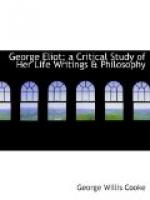George Eliot retains the traditional life, piety and symbolism of Christianity, but she undertakes to show they have quite another meaning than that usually given them. Her peculiarity is that she should wish to retain the form after the substance is gone. Comte undertook to give a new outward expression to those needs of the soul which lead to worship and piety; but George Eliot accepted the traditional symbolisms as far better than anything which can be invented. If we would do no violence to feeling and the inner needs of life, we must not break with the past, we must not destroy the temple of the soul. The traditional worship, piety and consecration, the poetic expression of feeling and sentiment, must be kept until new traditions, a new symbolism, have developed themselves out of the experiences of the race. God is a symbol for the great mystery of the universe and of being, the eternity and universality of law. Immortality is a symbol for the transmitted impulse which the person communicates to the race. The life and death of Christ is a symbol of that altruistic spirit of renunciation and sorrow willingly borne, by which humanity is being lifted up and brought towards its true destiny. Feeling demands these symbols, the heart craves for them. The bare enunciation of principles is not enough; they must be clothed upon by sentiment and affection. The Christian symbols answer to this need, they most fitly express this craving of the soul for a higher and purer life. The spontaneous, creative life of humanity has developed them as a fit mode of voicing its great spiritual cravings, and only the same creative genius can replace them. The inquiring intellect cannot furnish substitutes for them; rationalism utterly fails in all its attempts to satisfy the spiritual nature.
Such is George Eliot’s religion. It is the “Religion of Humanity” as interpreted by a woman, a poet and a genius. It differs from Comte’s as the work of a poet differs from that of a philosopher, as that of a woman differs from that of a man. His positive religion gives the impression of being invented; it is artificial, unreal. Hers is, at least, living and beautiful and impressive; it is warm, tender and full of compassion, He invents a new symbolism, a new hierarchy, and a new worship; that is, he remodels Catholicism to fit the Religion of Humanity. She is too sensible, too wise, or rather too poetic and sympathetic, to undertake such a transformation, or to be satisfied with it when accomplished by another. She gives a new poetic and spiritual meaning to the old faith and worship; and in doing this makes no break with tradition, rejects nothing of the old symbolism.




